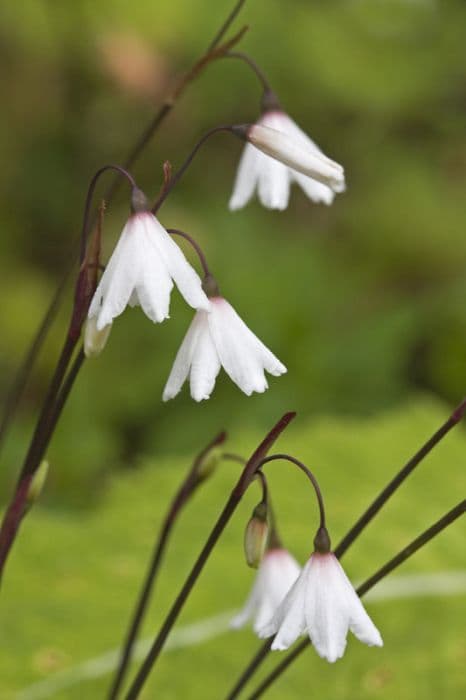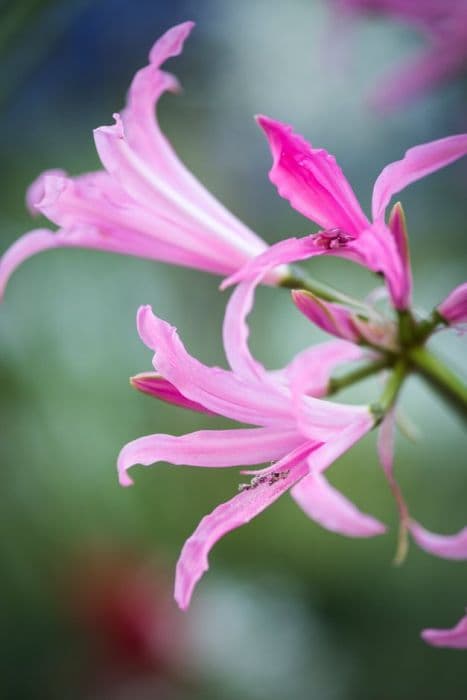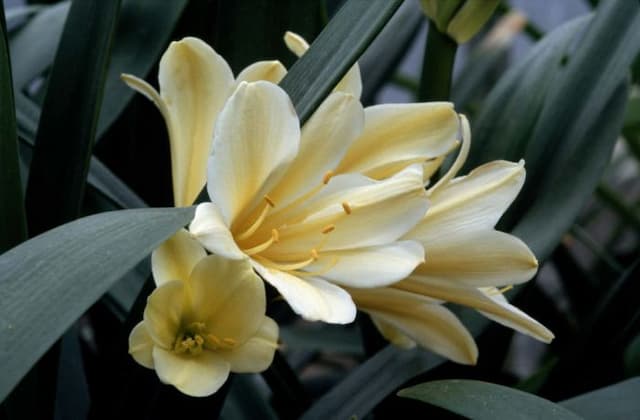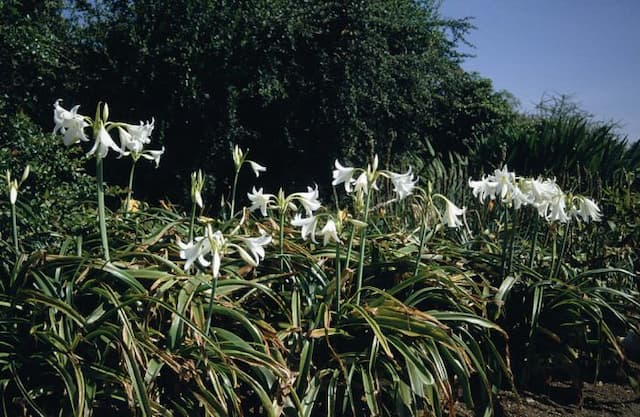White narcissus Narcissus moschatus (13)

ABOUT
Narcissus moschatus, commonly known as musk narcissus, features a distinctive appearance characterized by its elegant, trumpet-shaped flowers. These blooms are typically creamy white, exuding a gentle and captivating fragrance reminiscent of musk, which lends the plant its common name. The petals are elongated and slightly reflexed, forming a backdrop to the central cup or corona that can be a slightly paler or contrasting hue at the throat. This trumpet-like corona is a defining feature of this particular variety. The leaves of musk narcissus are long and strap-like, with a deep green color that forms a lush foil for the delicate blossoms above. The plant has a clumping habit, with the leaves emerging from a central point at the base and arching gracefully outward and up. The flowers are usually borne on upright stalks that rise above the foliage, each stalk typically holding a single bloom that nods or faces outward, giving the plant a poised and serene look. In gardens, musk narcissus often heralds the arrival of spring, punctuating the landscape with its charming flowers. Although the size of the plant is not to be mentioned, it is important to acknowledge that the flowers are proportionate to the overall scale of the plant, making it a notable addition to various garden settings. The plant’s visual appeal is enhanced by the light and airiness of the blossoms, creating a striking profile from early to mid-spring.
About this plant
 Names
NamesFamily
Amaryllidaceae
Synonyms
Swamp Narcissus, Musk Narcissus
Common names
Narcissus moschatus.
 Toxicity
ToxicityTo humans
The plant Narcissus moschatus, commonly known as Swamp Narcissus, is toxic to humans if ingested. The plant contains alkaloids such as lycorine, which can cause symptoms including nausea, vomiting, abdominal pain, and diarrhea. In serious cases, it can lead to cardiac arrhythmias, hypotension, tremors, convulsions, and in very severe instances, death. Handling the bulbs can cause skin irritation due to calcium oxalate crystals. Caution should be exercised to avoid ingestion and contact with the bulbs, particularly by children.
To pets
The plant Narcissus moschatus, commonly known as Swamp Narcissus, is also toxic to pets. Ingesting any part of the plant, particularly the bulbs, can cause symptoms such as vomiting, salivation, diarrhea, abdominal pain, tremors, seizures, and cardiac arrhythmias. Serious cases can result in significant clinical signs or even be fatal if not treated promptly. Pets should be prevented from accessing areas where Swamp Narcissus is planted.
 Characteristics
CharacteristicsLife cycle
Perennials
Foliage type
Deciduous
Color of leaves
Green
Flower color
Yellow
Height
1-2 feet [30-60 centimeters]
Spread
1 foot [30 centimeters]
Plant type
Bulb
Hardiness zones
3
Native area
Europe
Benefits
 General Benefits
General Benefits- Aesthetic Appeal: Narcissus moschatus, commonly known as the White Daffodil, offers a visually captivating display with its elegant white flowers, enhancing garden beauty and landscape design.
- Fragrance: The White Daffodil exudes a delicate and pleasant scent, contributing to a sensory garden experience.
- Attracts Pollinators: White Daffodils attract a variety of pollinators such as bees, which are crucial for pollinating other plants.
- Symbolism: Often associated with new beginnings and rebirth, White Daffodils have cultural significance especially in spring celebrations and festivities.
- Easy to Grow: White Daffodils are hardy and adaptable, making them suitable for gardeners of any skill level.
- Low Maintenance: Once established, White Daffodils require minimal care and are relatively drought-tolerant.
- Pest Resistance: These plants are generally resistant to pests and diseases, ensuring they remain healthy without extensive use of pesticides.
- Naturalizing: White Daffodils can spread and naturalize in an area over time, creating a self-sustaining population.
- Cut Flowers: The blooms of the White Daffodil are long-lasting when cut, making them ideal for floral arrangements and bouquets.
- Deer Resistant: Often overlooked by deer, White Daffodils are excellent for areas where deer browsing can be a problem.
- Seasonal Interest: White Daffodils typically bloom in the spring, providing seasonal color and interest during that time.
 Medical Properties
Medical Properties- This plant is not used for medical purposes.
 Air-purifying Qualities
Air-purifying QualitiesThis plant is not specifically known for air purifying qualities.
 Other Uses
Other Uses- Perfumery: Narcissus moschatus is often used in perfumery for its strong, musky fragrance that is highly valued in the creation of floral scent profiles.
- Garden Design: Due to its elegant shape and color, the plant is used in garden design to create focal points or to add a romantic cottage feel to garden beds and borders.
- Floral Displays: The flowers of Narcissus moschatus are commonly used in floral arrangements and bouquets for weddings and other special occasions because of their attractive appearance and scent.
- Photography: The distinctive flowers are frequently used as subjects in botanical and garden photography, adored for their pure white petals and photogenic qualities.
- Eco-Friendly Dye: The blooms can be used to create a natural yellow dye for fabrics, offering an eco-friendly alternative to synthetic dyes.
- Potpourri: Dried Narcissus moschatus flowers are included in potpourri mixes to provide a long-lasting fragrance in homes and drawers.
- Cultural Symbolism: The plant is often used as a symbol of vanity and self-admiration in art and literature, drawing on the Greek myth of Narcissus.
- Education: Botanical gardens and educational programs may use Narcissus moschatus to teach about plant biology, particularly bulbous plant species and their life cycles.
- Festivals: In some regions, Narcissus moschatus flowers play a role in spring festivals celebrating the arrival of the new season and the beauty of nature.
- Collector's Item: Certain cultivars of the plant are sought after by horticultural enthusiasts and plant collectors for their unique characteristics and rarity.
Interesting Facts
 Feng Shui
Feng ShuiThe Narcissus is not used in Feng Shui practice.
 Zodiac Sign Compitability
Zodiac Sign CompitabilityThe Narcissus is not used in astrology practice.
 Plant Symbolism
Plant Symbolism- Rebirth: As a spring-blooming flower, the Narcissus (often referred to as Daffodil) symbolizes new beginnings and the renewal of life.
- Unrequited Love: According to Greek mythology, from which the name originates, Narcissus fell in love with his own reflection, representing unrequited love.
- Self-Esteem: The flower's connection to the Narcissus myth has also made it a symbol for self-love and vanity.
- Prosperity: Celebrated during Chinese New Year, the Narcissus is believed to bring wealth and good fortune when it blooms.
- Creativity: The Narcissus is said to inspire creativity, due to its bright and appealing bloom that sparks imagination.
- Hope: Its arrival in the late winter and early spring months signifies the end of cold days and the hope for warmer weather.
 Water
WaterSwan plant, commonly known as Narcissus moschatus, should be watered thoroughly when the top inch of soil feels dry to the touch, approximately once a week. The exact frequency of watering can vary depending on environmental conditions and the size of the plant, but a good rule of thumb is to check the soil moisture regularly. When watering, provide enough water so that it runs freely from the drainage holes, indicating the soil is saturated. Be cautious not to overwater, as Narcissus prefers to be on the drier side rather than waterlogged. On average, this may equate to about 1 gallon of water per plant every 7 to 10 days, but adjust for the plant's size and local climate conditions.
 Light
LightNarcissus moschatus, or Swan plant, thrives in bright, indirect light or dappled sunlight. It is best positioned in a spot where it receives morning sun and afternoon shade, or where sunlight is filtered through a curtain or blind. Direct midday sun can be too intense and may damage the leaves, so it’s important to find a balance for optimal growth.
 Temperature
TemperatureThe Swan plant or Narcissus moschatus fares best in temperatures between 50 and 70°F. It can survive minimum temperatures down to about 40°F for brief periods. Avoid exposing the plant to temperatures below freezing, as this can cause significant damage. The ideal conditions are a moderate climate where temperatures do not swing too drastically throughout the year.
 Pruning
PruningPruning the Swan plant, or Narcissus moschatus, is generally focused on removing spent flowers and yellowing leaves to encourage healthy growth and improve the plant's appearance. The best time to prune is after the plant has finished blooming, usually in late spring or early summer. Pruning is not frequent, only as needed after flowering, to tidy up the plant and direct its energy to new growth.
 Cleaning
CleaningAs needed
 Soil
SoilSwamp Narcissus prefers moist, well-draining soil with a rich composition of organic matter. The best mix is equal parts loam, sand, and peat with a slightly acidic to neutral pH of 6.0 to 7.0.
 Repotting
RepottingSwamp Narcissus, commonly grown from bulbs, does not need frequent repotting. Repot once every 3 to 4 years, or when the bulbs multiply and overcrowd their container.
 Humidity & Misting
Humidity & MistingSwamp Narcissus thrives in moderate to high humidity levels, ensuring the air is not too dry, which is typical of its natural moist habitat conditions.
 Suitable locations
Suitable locationsIndoor
Place in bright, indirect light and keep soil moist.
Outdoor
Plant in partial shade, keep soil moist, protect from harsh sun.
Hardiness zone
3-9 USDA
 Life cycle
Life cycleNarcissus moschatus, commonly known as Swan's Neck Daffodil, starts its life cycle with seed germination, usually in late spring or early summer. The seeds develop into a bulb which overwinters underground. In spring, the bulb sends up green, leafy growth and a single flower stalk, which produces the characteristic white, often nodding flowers. After flowering, the plant goes through a period of photosynthesis to store energy in the bulb while the foliage dies back. The bulb enters a dormant period during the hot summer months, conserving energy for the next growing season. The cycle repeats annually, with bulbs capable of clonal reproduction by producing offsets, which can be separated and planted to propagate new plants.
 Propogation
PropogationPropogation time
Spring
Propogation: The most popular method of propagation for Narcissus moschatus, commonly known as Swan's Neck Daffodil, is through dividing and transplanting its bulbs. Typically, the best time to propagate these plants is in late summer to early fall, after the foliage has died back. Gardeners usually lift the clumps of bulbs and gently separate them, ensuring that each division has at least one growing point. The bulbs should then be replanted immediately at a depth of about 6 inches (15 centimeters) and spaced approximately 6 inches (15 centimeters) apart to give them enough room to grow. Through this process, the Swan's Neck Daffodil can be effectively multiplied, ensuring blooms for the following spring.









